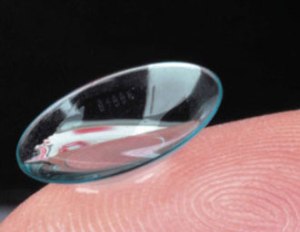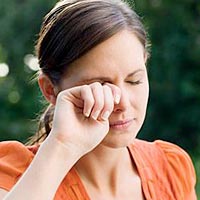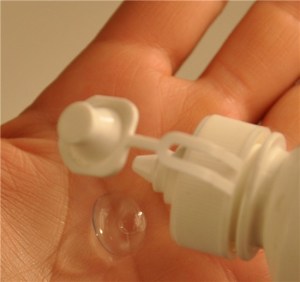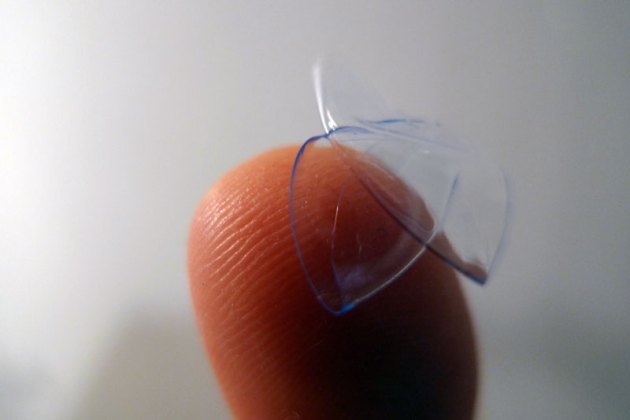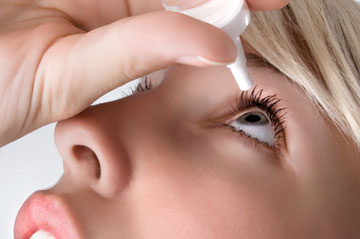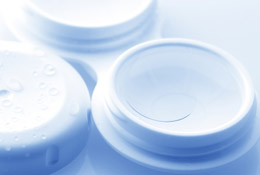What are contact lenses?
Contact lenses are small, thin discs made of a transparent material. The outer surfaces are custom-shaped to correct or improve vision and the inner side is carefully formed to fit the surface of the cornea (the clear, front covering of the eye including the iris and pupil). Today, the lenses are typically soft (flexible) but hard (rigid) are still available.
Contact lenses can be a safe and effective way to correct vision for most people. However, people who wear them must follow the directions of their eye specialist – this care includes how long the lenses can be worn continuously, how they should be cleaned and stored, and the good hygiene practices to follow when wearing or handling the lenses.
Many people wear contact lenses because they prefer them to eye glasses – contact lenses do not slip down your nose or fog up in the wintertime. A few people, however, must wear contact lenses to have adequate vision (for example, after cataract surgery, or for medical conditions such as keratoconus – a deformity of the cornea).
Contact lenses can cause some problems that do not produce any symptoms that the contact lens wearer may not notice. For this reason, contact lens wearers should have regular checkups with a specialist who prescribes and fits contact lenses.
What is the controversy about wearing contact lenses at work?
Put as simply as possible, the problem is that, according to some people, contact lenses may complicate eye safety.
The arguments against wearing contact lenses in the work environment are based on the following:
•Dusts or chemicals can be trapped behind the lens and cause irritation or damage to the cornea or both;
•Gases and vapours can cause irritation and excessive eye watering; and
•Chemical splash may be more injurious when contact lenses are worn. This increased risk is related to the removal of the lenses. If removal is delayed, first aid treatment may not be as effective and, in turn, the eye’s exposure time to the chemical may be increased.
However, the opposite may be true as well. Contact lenses may prevent some substances from reaching the eye, and thus minimize or even prevent an injury. Both situations have been documented.
As a result, a wide range of opinions about the safety of contact lenses in the workplace has formed. More complete information is hard to find since occupational injury reporting systems do not typically include information about contact lens use.
The critical point to remember is that contact lenses are not intended to be used as protective devices. They are not a substitute for personal protective equipment (PPE) – if eye and face protection is required for certain work operations then all workers, including contact lens wearers, should wear the proper protective devices. Safe work conditions for all workers are only possible when basic occupational health and safety practices and procedures are followed.
Are there situations where it may be hazardous to wear contact lenses?
While these conditions may be hazardous to both contact lenses wearers and to people who do not, contact lens wearers should be aware that certain conditions may make it necessary to avoid wearing their lenses. Each situation should be carefully investigated. These situations may include:
•Exposure to chemical fumes and vapours,
•Areas where potential for chemical splash exists,
•Areas where particulate matter or dust is in the atmosphere,
•Exposure to extremes of infrared rays,
•Intense heat,
•Dry atmosphere,
•Flying particles, and
•Areas where caustic substances are handled, particularly those used or stored under pressure.
In workplaces with ultra-violet and infrared radiation sources, users of contact lenses require protection just as persons not wearing contact lenses do. Contact lens types absorb infrared radiation. This effect is potentially more harmful to the soft lens wearer as it could alter the water balance of the contact lens.
Are some hazards specific to soft contact lens wearers?
Soft lenses are made from a type of plastic that contains a large proportion of water. The soft lense adheres more tightly to the cornea and does not have as much fluid motion as the hard contact lens. For these reasons, some researchers think the soft lens offers some, but not total, protection against entrapment of foreign substances between the contact lens and the cornea.
The major risks for soft contact lens wearers are from chemical splashes and from hot, dry environments. Because of the high water content of the soft contact lens, some chemicals can pass through the lens and be held against the cornea by the lens itself.
Hot, dry environments can lead to problems because they can cause the tear layer (upon which the lens ‘sits’) to dehydrate . This situation results in eye discomfort.
Are some hazards specific for hard contact lens wearers?
Hard lenses are made from an impervious material. Increased risk may result if foreign substances, such as dust or small metal fragments, become trapped behind the contact lens. Since the hard contact lens floats on the tear film in front of the cornea (not in a fixed position), there may be an abrading action between the contact lens and the foreign substance that may result in injury to the cornea. Also, chemicals may become trapped behind the contact lens and held in place against the cornea. In dirty, dusty environments, the wearing of hard lenses may be more hazardous than soft contact lenses.
What are some other possible concerns when wearing contact lenses?
A contact lens wearer working alone or in a remote area may be at greater risk if hurt with an eye injury. The immediate removal of contact lenses may be important and the injured wearer may be unable to do this. Also, equipment (e.g., eyewash stations) and qualified staff may not be immediately available which, in turn, increases the risk of further damage.
Dislodgement or sudden loss of a contact lens is another problem. The first complication creates sudden changes in vision quality due to decreased visual acuity and blurring. These pose obvious dangers if dislodgement should occur at a moment when sight is essential for safety. The same problems could occur for wearers of glasses though contact lenses may be easier to lose and are more difficult to re-position.
Can contact lenses be worn in a hazardous workplace environment?
Be aware that contact lenses themselves do not provide eye protection in the industrial sense.
In any environment where industrial eye protection is required, contact lenses should not be worn, except under special medical circumstances (in consultation with a qualified medical professional). If individual medical circumstances require that contact lenses be worn in such environments, eye protection must also be used.
How do I identify eye hazards for contact lens wearers?
To ensure the safe use of contact lenses in the work environment, occupational health and safety principles must be applied to identify and control any possible hazards.
The most common hazards to contact lens wearers have been discussed. Quantification of hazards is difficult and a variety of complex approaches have been developed. However, the most useful way of evaluating the risk is to classify it as either acceptable or not acceptable.
If the risks of wearing contact lenses in a particular environment are found to be within acceptable limits, then the only course of action needed is ongoing monitoring of the situation.
If the risks are found to be unacceptable, then further action is required to eliminate existing hazards or to reduce hazards to acceptable levels.
Tips for wearing Contact Lenses at Work.
•Take special care to keep contact lenses clean. Follow the advice of your Optometrist.
•Discuss your work environment and any possible hazards with your eye care specialist.
•Make sure that fellow employees and the employer know that you are wearing contact lenses.
•Be alert for changes to the work process and changes to environmental conditions that may be hazardous to you.
•Keep eye glasses available for unforseen circumstances.
•Wear personal protective equipment whenever required.
•Learn about eye hazards and encourage your employer and joint health and safety committee members to do the same.
Source: http://www.ccohs.ca/oshanswers/prevention/contact_len.html
